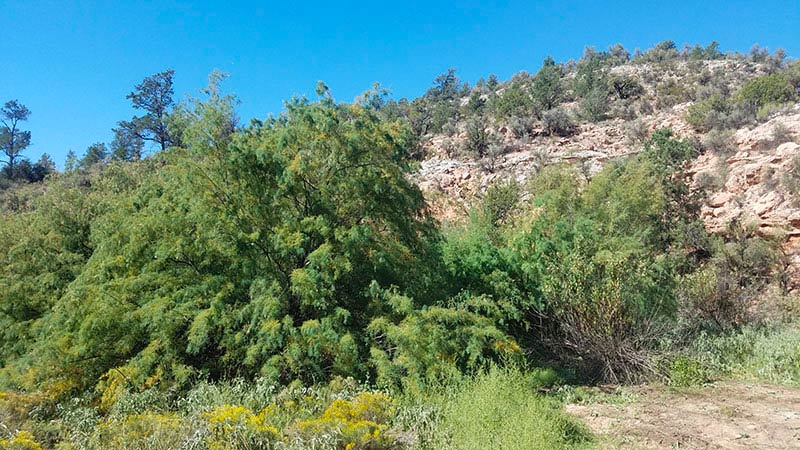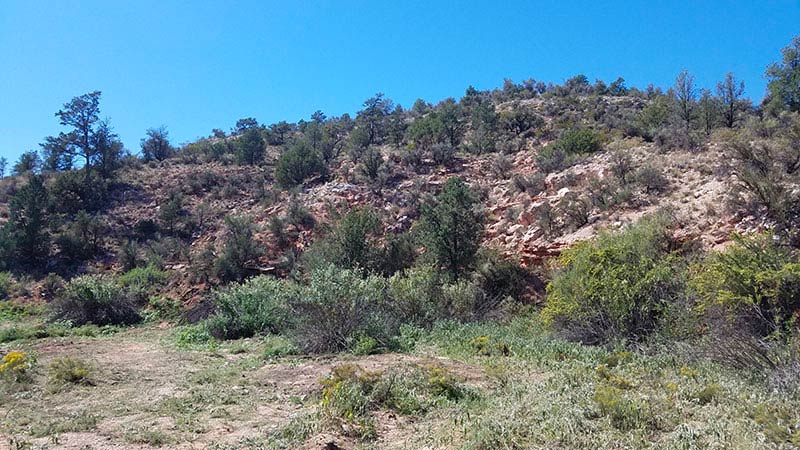What We Do
Any river is really the summation of the whole valley. To think of it as nothing but water is to ignore the greater part.
Hal Borland
What We Do
Verde River Cooperative Invasive Plant Management
The Verde River has a large variety of native plant species that provide wildlife habitat and promote a healthy river system. Invasive, non-native plants can outcompete native plants, especially in times of drought and a warming climate. The invasive plants that Friends of the Verde River works to manage can have devastating impacts on the balance of the riparian forest ecosystem. Some impacts include:
- Increased risk of fire
- Causing river water to warm up because of adequate shade
- Leaving no room for native plants that wildlife depend upon for survival
- Forming dense stands that block access to the river to both humans and wildlife
Friends works with private landowners and public land managers to remove invasive plants. We focus on the riparian areas along the Verde River and its tributaries. Since 2010, we have removed invasive plants from over 10,400 acres. We continue to monitor and treat these areas to remove invasives. Our work promotes the regrowth of native plant species, protecting the rare Fremont cottonwood-Goodding’s willow gallery forest.
What is a Non-Native Invasive Plant
A non-native, invasive plant is a plant from another region or continent, that is introduced into a new environment (in our case the Verde Valley), where it spreads aggressively, and is difficult and costly to control. Officially, a non-native, invasive species is defined as “a species whose introduction causes or is likely to cause economic or environmental harm, or harm to human health.”
In its new environment, a non-native, invasive plant is free from the other plant is free from the other plants, insects, and pathogens – the natural “checks and balances” – that kept it under control in its native range.
Once established, populations of non-native, invasive plants can harm property values, wildlife habitat, water quality, and recreational access. Some non-native invasive plants in the Verde Valley increase the frequency and intensity of wildfire, and others are toxic to livestock.
One of our priority invasive plants for control is tamarisk, or saltcedar, which colonizes rivers and streams. Left unchecked, tamarisk can create monocultures – dense stands where nothing but tamarisk grows. While an individual tamarisk tree does not necessarily use more water, tree-for-tree, than a native cottonwood or sycamore, tamarisk stands are denser, and more trees per acre means more water use. In an arid watershed like the Verde, this can contribute to drying up our surface and groundwater systems.
Before Tamarisk Removal
After Tamarisk Removal
Priority Non-Native Invasive Plants
VWRC’s Big Four (considered to be the biggest threats to the natural functioning of the watershed)
Tamarisk/Saltcedar – Tamarix spp.
Tamarisk is one of the most widely distributed and troublesome nonnative, invasive plants along water courses in the southwestern United States.
A semi-deciduous, loosely branched shrub or small to medium-sized tree. It can be identified by a few characteristics:
- reddish, slender, arching branches
- pale gray-green scale-like leaves
- plumes of pink 5-petaled flowers in early to mid-summer
This tree was introduced throughout the western United States from Eurasia as an ornamental and for windbreaks. It escaped from cultivation infesting floodplains, riverbanks, ditches, marshes, waste areas and roadsides; including many natural areas and state and national parks and monuments. It forms dense impenetrable thickets that crowd out native plants. It accumulates salt in its tissues, which is later released into the soil, making it unsuitable for many native species. It will colonize along rivers and streams, dropping seed into the water for distribution and further colonization downstream.
Mature tamarisks have deep, extensive root system that make physical removal a daunting task. The dense stands that tamarisk forms along with the large quantities of dead branches and leaf litter are caught in tamarisk branches increases the likelihood and impacts of wildfire in areas where it grows unchecked.
-
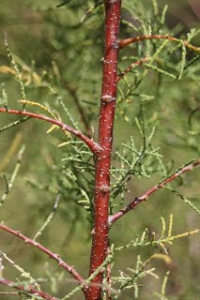
Tamarisk Branch
-
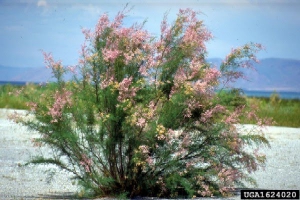
Tamarisk Flowers
Giant Reed/Giant Cane – Arundo Donax
Giant Reed/Giant Cane is a tall rhizomatous perennial grass. Introduced from Southeast Asia as an ornamental, it is invasive throughout the warmer freshwaters of the United States from Maryland westward to northern California.
Once established, it tends to form large, continuous, clonal root masses, sometimes covering several acres. Giant reed grows very rapidly and can establish quickly from fragmented rhizomes or stem nodes that take root.
Giant reed provides neither food nor habitat for native species of wildlife as it produces a wide array of chemicals that protect it from most native insects and grazers.
-
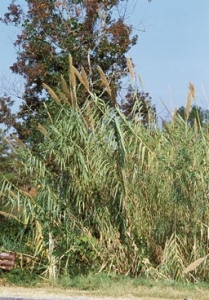
Giant Reed
-
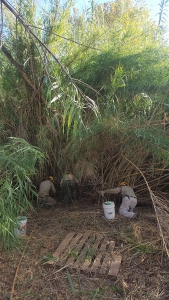
Giant Reed Removal
Tree Of Heaven/Paradise Tree/Stink Tree/Chinese Sumac - Ailanthus Altissima
Tree of heaven is a twiggy rapidly growing tree. Originally introduced from Taiwan and central China as an ornamental it was soon abandoned due to its foul smell and suckering.
It will sprout aggressively when cut back from an extensive root system. Dense clonal thickets will displace native species, filling large areas quickly. Additionally tree of heaven roots and clonal sprouts will push up through concrete cracks and will damage buildings and water systems.
With its pinnate leaves it resembles sumacs and hickories but can be distinguished by the following traits:
- large heart-shaped leaf scars on the twigs
- glandular, notched base on each leaflet
- lacks serrate leaf margins
-
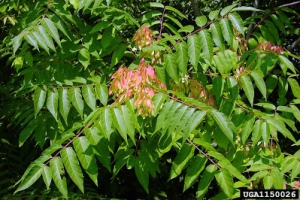
Tree of Heaven Flowers
-
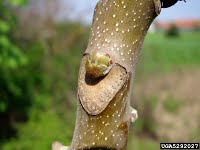
Tree of Heaven Branch
Russian Olive – Elaeagnus Angustifolia
Russian olive is a multi-stemmed deciduous bush or small tree. It was introduced from western/central Asia as a windbreak species and an ornamental.
Its identifiable characteristics:
- dark, smooth and sometimes shredding bark
- Young branches are silvery and often bearing course thorns.
- The leaves are generally lanceolate to oblong in shape.
- They bloom in early summer in small clusters of 1 cm long, highly fragrant flowers with a four-lobed creamy yellow calyx.
- The silvery brown fruit that result are what give the tree its name despite not being of the olive family.
Russian-olive can resemble some willow species with light green foliage, particularly sandbar willow. However, unlike Russian-olive, willows have inconspicuous flowers on erect stalks and small, wind-dispersed seeds. The seeds of the Russian olive are spread by birds that savor the fruit and some vegetative propagation.
Russian-olive is an invasive species in many places in the United States but is most invasive in riparian areas in the western U.S. Its ability to fix nitrogen that allows it to thrive on poor soil, its low seedling mortality rates, and rapid maturation helps it outcompete native vegetation. Although this species is used by wildlife it is used to a lesser degree than native vegetation. For instance native beaver rarely harvest Russian-olive trees. Additionally, some authors have suggested that Russian-olive may alter stream hydrology and nutrient cycling.
-
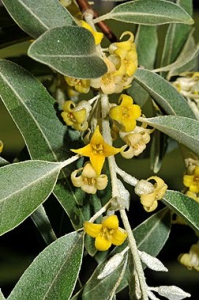
Russian Olive Flowers
-
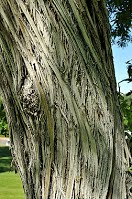
Russian Olive Bark
Other Notable Invasives
- Creeping Waterprimrose – Ludwigia peploides
- Dalmatian Toadflax – Linaria dalmatica
- Eurasian Watermilfoil – Myriophyllum spicatum
- Himalayan Blackberry – Rubus armeniacus
- Malta Starthistle – Centaurea melitensis
- Mexican Fireweed/Kochia – Bassia scoparia
- Russian Knapweed – Acroptilon repens
- Sahara Mustard – Brassica tournefortii
- Spotted Knapweed – Centaurea stoebe
- Sweetclover – Melilotus officinalis
- Uruguayan Pampas Grass – Cortaderia selloana
- Water Lily – Nymphaea spp.
- Yellow Starthistle – Centaurea solstitialis
References
Zouhar, Kris. 2003. Tamarix spp. U.S. Department of Agriculture, Forest Service, Rocky Mountain Research Station, Fire Sciences Laboratory, http://www.fs.fed.us/database/feis/plants/tree/tamspp/all.html, accessed on Dec 10 2013
Gaskin, John F. 2012. Tamarix, in Jepson Flora Project (eds.) Jepson eFlora, http://ucjeps.berkeley.edu/cgi-bin/get_IJM.pl?tid=46076, accessed on Dec 10 2013
McWilliams, Jack. 2004. Arundo donax. U.S. Department of Agriculture, Forest Service, Rocky Mountain Research Station, Fire Sciences Laboratory (Producer). http://www.fs.fed.us/database/feis/plants/graminoid/arudon/all.html, Accessed on Dec 10 2013
Fryer, Janet L. 2010. Ailanthus altissima. In: Fire Effects Information System, [Online]. U.S. Department of Agriculture, Forest Service, Rocky Mountain Research Station, Fire Sciences Laboratory (Producer). Available: http://www.fs.fed.us/database/feis/ [2013, December 12]
Bargeron, C.T., C.R. Minteer, C.W. Evans, D.J. Moorhead, G.K. Douce and R.C. Reardon. Technical Coordinators. 2008. Invasive Plants of the United States DVD-ROM: Identification, Biology and Control. USDA Forest Service. Forest Health Technology Enterprise Team. Morgantown, WV. FHTET-08-11
Zouhar, Kris. 2005. Elaeagnus angustifolia. In: Fire Effects Information System, [Online]. U.S. Department of Agriculture, Forest Service, Rocky Mountain Research Station, Fire Sciences Laboratory (Producer). Available: http://www.fs.fed.us/database/feis/
Tu, Mandy. 2005. Element Stewardship Abstract for Elaeagnus angustafolia. The Nature Conservancy’s Wildland Invasive Species Team. http://www.imapinvasives.org/GIST/ESA/esapages/elaeangu.html
Questions? Contact Us.
For any questions or concerns, please contact


